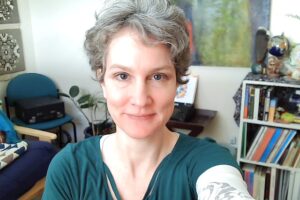A Modern Author’s Guide to the Evolution of Story: Transforming the Journey Beyond the Hero and Heroine
Storytelling is an art. As art tends to do, it evolves with the times, often questioning its roots yet keeping a keen eye on those who came before.
The premise of this article is to take a look at the roots of journey in storytelling, question them, and create a renewed perspective while also bringing forth two examples of evolving story journeys.
The purpose of focusing on two story journeys is to get to the heart of the journey. The essence of the way a story is told. From there, a writer can expand upon key elements to bring the story into life. And yet, doing so from a more evolved perspective of inclusivity and diverse human experiences.
Citations: 1. Lucas Seastrom, October 22, 2015, (website) https://www.starwars.com/news/mythic-discovery-within-the-inner-reaches-of-outer-space-joseph-campbell-meets-george-lucas-part-i. 2. Christopher Vogler, The Writer’s Journey: Mythic Structure for Writers, 3rd Edition, (Ventura, CA: Michael Wiese Productions, 2007), 3 3. Maureen Murdock, “The Heroine’s Journey,” Maureen Murdock (website) https://maureenmurdock.com/articles/articles-the-heroines-journey/. 4. Maureen Murdock, The Heroine’s Journey, (Boulder, CO, Shambhala, 1990). 5. Gail Carriger, The Heroine’s Journey, (Gail Carriger LLC, 2020) 6. Christopher Vogler, The Writer’s Journey: Mythic Structure for Writers, 3rd Edition, (Ventura, CA: Michael Wiese Productions, 2007), xix.
 Regina Stribling is a Developmental Editor at Manuscripts, LLC. One of her passions is helping writers create powerful, transformative memoirs with universal themes. Her current personal writing project, The Last Time Guardian, is a mindbending and heartwarming speculative novel that is being pitched to agents. Regina has appeared on local radio shows for poetry in Colorado (KGNU Boulder, and KRFC Fort Collins). Connect with Regina to experience her flair for the otherworldly and penchant for helping writers tell their transformational stories.
Regina Stribling is a Developmental Editor at Manuscripts, LLC. One of her passions is helping writers create powerful, transformative memoirs with universal themes. Her current personal writing project, The Last Time Guardian, is a mindbending and heartwarming speculative novel that is being pitched to agents. Regina has appeared on local radio shows for poetry in Colorado (KGNU Boulder, and KRFC Fort Collins). Connect with Regina to experience her flair for the otherworldly and penchant for helping writers tell their transformational stories.
Hero’s Journey in a Nutshell
Are you a fan of the Star Wars movies? Did you know George Lucas adapted Joseph Campbell’s A Hero with a Thousand Faces into the first Star Wars series and that George referred to Joseph as “my Yoda”? 1 It wasn’t until the 1980’s that Joseph learned about George’s direct reference to the monomyth in Star Wars. Campbell revered the first Star Wars movies as works of art. Joseph Campbell’s extensive work in analyzing myths around the world created a framework for storytellers to follow. A journey of adventure and personal transformation with specific stages of trials, mentors, conflicts, rewards, sacrifices, battles, and coming home. The hero’s journey has changed the way stories are told, at least in America and the Western world. Luke Skywalker became a benchmark for how to write a story based upon the hero’s journey. Christopher Vogler enhanced the hero’s journey in Hollywood’s storytelling. As a former story consultant for Disney and story analyst for 20th Century Fox and Paramount, Vogler is well-versed at bringing the hero’s journey into this big arena. In regard to why the hero’s journey has spread in Hollywood like wildfire, Vogler says, “With these tools you can construct a story to meet almost any situation, a story that will be dramatic, entertaining, and psychologically true.” 2 Psychologically true for whom? Does the hero’s journey apply to everyone, as Joseph would have liked, or is it outdated? Vogler admits in his third edition of The Writer’s Journey that even though the hero’s journey is universal, women may have different needs and focuses of their journeys.Heroine’s Journey in a Nutshell
Maureen Murdock, the author of The Heroine’s Journey, was a student of Joseph Campbell. When she expressed to him that his model didn’t account for women’s mythologies and the contemporary feminine experience, he replied, “Women don’t need to make the journey. In the whole mythological tradition the woman is there. All she has to do is to realize that she’s the place that people are trying to get to.” 3 In response, she wrote The Heroine’s Journey. 4 Her book is about the psychological and spiritual struggle for women who have taken on the hero’s journey in response to surviving the patriarchy—the book shows women how to come back to themselves and embrace a journey more true to the feminine experience. A bit different than Gail Carriger’s version, although there are similarities. Gail’s Heroine’s Journey 5 focuses on three goddess myths and archetypes for writers to create a potential outline or core story beats. She gives detailed examples of these myths that organically unfold in a compelling way of storytelling. Carriger also includes fascinating pop culture examples of what are and are not heroine’s journeys. Both Maureen and Gail mention how women often react to their situations rather than taking action. This comes from women being part of a marginalized group. More to the point, any peoples who have felt victimized have difficulty rising up to take action. This is where some editors may ask for a character to have more agency. But, there is a balance between acting and reacting. I believe the heroine’s journey is about empowering oneself and/or one’s main character to overcome great odds and gain agency. Balanced with self-care. And, with the help of friends, mentors, and communities. To include more community-based intersection of relationships and self-actualization stand-points.What About Everyone Else . . .
What about people of color and marginalized folk? The aboriginal people of Australia pointed out to Vogler how the hero’s journey has “hidden cultural assumptions . . .” 6 What about the gender fluidity folk? What journey do they follow? Gail Carriger asserts the heroine’s journey is not based on gender. However, it’s been pointed out that the very name of the journey is gender biased. What about the wonder women and dark phoenixes of the world? What about the men who are meditators, artists, and healers?The Evolving Journeys
If life and storytelling are all about the journey, and the type of journey is what matters most, then it’s important to look at more inclusive ways to write stories! As writers, it’s our responsibility to acknowledge the power we have in inspiring and influencing people’s lives through our words. It’s vital for us to consider how our characters and their journeys affect our readers. Is it a matter of balancing the key aspects of the hero’s journey and heroine’s journey in a way that is more inclusive of diverse ways of living? Or do we attempt to create new journeys? The answer lives within the diversity of experience our readers desire to read by creating evolved journeys. It’s an ambitious undertaking to reconsider Campbell’s monomyth and Murdock’s and Carriger’s heroine’s journeys. This is where keeping a keen eye on the roots of their creations is important. The work in evolving story journeys stems from acknowledging the inherent essence alive in the heart of storytelling. The following two journeys are based on the key aspects inherent in: plot driven vs. character driven stories, hero (as outlined by Vogler) vs. heroine (as outlined by Carriger and Murdock) stories, and internal vs. external stories. To be clear, some of these elements cross over into each other because being human is a fluid experience. The emphasis is on the specific focus within each journey: mission or transformation. The focus is the key that delineates the type of journey a character is taking while also allowing creative space to explore diverse arcs. I invite you to consider whether you can identify specific books and movies that would fall into these evolved journeys quite easily. I’ve provided a few examples of archetypes and stories to consider for each.Mission Based Journey
Story focus: These stories are action and plot driven based upon achieving a goal or a mission. The main character’s overall goal/mission can include bettering the world; however, it usually is based on stopping danger, or completing a project or series of projects toward one aim or one sector of society. The character’s choices and actions bring about the major changes in the story’s arc. Action oriented: The main character must focus on achieving a specific goal or mission by taking specific external actions to get there. The choices made by the main character drive the story. Their actions are the primary way the main character achieves the end goal or mission. System/World: The community, system, and/or world is what the character battles against and pushes up against to gain the goal/mission. Solo: The main character generally goes the journey alone with help from a mentor, friends, or network. However, their stories aren’t about achieving friends and community. Their stories are about succeeding at their goal/mission, sometimes at the cost of losing friends/family. But they march on. Agency: The character already has some form of agency that builds when accomplishing tasks, overcoming external obstacles/challenges, or succeeding at learning from a mentor or through experimentation. Learning from mistakes or missteps is a big part of the main character’s motivation to continue to take action. Aggressive battles: The story includes aggressive battles, fights, or killing the enemy. Internal transformation: The character may undergo a small transformation; however, transformation is not the main focus of the journey. The main focus is achieving the goal at whatever cost. Crisis: The main character must go through a crisis that nearly devastates their forward progress. This is the key mission commitment moment where the character makes a pivotal choice that propels them forward on completing their mission. Usually includes external antagonists attempting to thwart their progress. Archetypes (as patterns of behavior): Warrior, Scientist, Entrepreneur, Detective, Goddesses/Gods of war/battle/action, Adventurers/Explorer, Ruler (rather than sovereigns), Outlaw, Achiever, Magician (externally focused). Story examples: Trail of Lightning by Rebecca Roanhorse, Upgrade by Blake Crouch, Dune by Frank Herbert, Jack Reacher character, 2017 movie Wonder Woman.Transformation-System Change Based Journey
Story focus: These stories are both action and internally driven, or character and plot driven, based upon a character undergoing a personal transformation to change a system. The main focus for this type of journey is for the main character to move through challenges/obstacles (external and internal) toward a more enlightened and authentic state of being in order to feel fulfilled by the end of the story. Psychological and/or spiritual development is a big part of the main character’s transformation. The character must go through an internal transformation in order to reach a goal, or build a community, or change a system. Changing a system: A large focus of the character’s journey is on changing a system (family, community, network, or world system). The character’s family, community/network, and/or world is the external container that pushes up against them for the inner transformation to occur. Some members of family, friends, and/or community may assist with forward progress by helping the main character learn lessons along an internal and external arc. Speaking out or acting against antagonists becomes a group/team or partnered effort to change an oppressive or unenlightened system. And yet, the character must reach a more enlightened place within the self (working with defenses, emotions, psychological inner battles) to be able to affect change without raging against the system, but instead finding more subtle loopholes to transform the system. Rage may be present; however, it’s sublimated into agency and forward progress. No aggressive battles: The story doesn’t include aggressive battles, fights, or killing the enemy. Instead, the main character must look within the self to identify how the antagonists are affecting them to then sublimate defenses and extend compassion while also building character agency, so the character will no longer be intimidated, oppressed, or overrun by antagonists or their systems. Breakthrough moment: The main character must have a breakthrough moment. This is the key transformational moment of self-awareness where the character makes a pivotal choice that propels them forward on their path toward fulfillment. Integration: Integration is a key element occurring throughout the story so the character gains the agency, wisdom, and wherewithal to change the system. The main integration of the entire journey cycle is toward the culmination of the story where the main character integrates the lessons learned and embodies more of their actualized self to then bring those lessons into the family, community, network, or world’s systems. Mission: The main character may be on a mission; however, they must undergo an internal transformation with the help of mentors, friends, or community in order to achieve this mission. Friendships/Community: Friends, family, and community, including mentors, are a large part of how the main character survives their challenges. The main character may lose friends/family/community, and when they do it comes as a hit to their internal transformation. This means the loss must become part of the transformational journey that needs to occur for the character so that a “surrogate” family and/or network can be rebuilt as an aid in moving forward on the journey. The “surrogate” or rebuilt network helps create fulfillment in the end, including a better world. Agency: The main character is self-effacing and must find agency through difficult choices and reactions to others. They may achieve agency through completing tasks such as learning from a mentor; however, they learn the most from reflecting on and considering what they’ve learned about those tasks and/or what their mentor is asking of them. Bettering the world: The character’s overall transformation can include bettering the world and is usually connected to creating more enlightened communities, awakening to a greater understanding of how the world works, what needs to occur to change the system, and/or helping others make changes for the better of society. Archetypes (as patterns of behavior): Teacher, Mentor, Change Agent, Goddesses connected to transformational journeys (such as Inanna, Mary Magdalene, Isis), transformationally focused Queens/Kings (sovereigns), Artist, Healer, Shaman, Lover, Caregiver, Sage, Reformer Story examples: Harry Potter series by J.K Rowling, Hunger Games series by Suzanne Collins, Akata Witch series by Nnedi Okorafor, Wizard of Oz by L. Frank Baum. * * * The opportunity to write compelling and relevant stories lives within each of us as writers. It’s because we can sit at the table with Campbell, Vogler, Murdock, and Carriger that we can create a renewed storytelling journey. Remembering our roots as storytellers allows for more richness and aliveness to occur in our stories. There may be some universal aspects within both the hero and heroine’s journeys, but not all stages of these journeys apply to everyone. My hope is that the evolving journeys outlined here allow for writers to branch out into more inclusive stories with a clear heart of focus and a keen connection to their roots.Citations: 1. Lucas Seastrom, October 22, 2015, (website) https://www.starwars.com/news/mythic-discovery-within-the-inner-reaches-of-outer-space-joseph-campbell-meets-george-lucas-part-i. 2. Christopher Vogler, The Writer’s Journey: Mythic Structure for Writers, 3rd Edition, (Ventura, CA: Michael Wiese Productions, 2007), 3 3. Maureen Murdock, “The Heroine’s Journey,” Maureen Murdock (website) https://maureenmurdock.com/articles/articles-the-heroines-journey/. 4. Maureen Murdock, The Heroine’s Journey, (Boulder, CO, Shambhala, 1990). 5. Gail Carriger, The Heroine’s Journey, (Gail Carriger LLC, 2020) 6. Christopher Vogler, The Writer’s Journey: Mythic Structure for Writers, 3rd Edition, (Ventura, CA: Michael Wiese Productions, 2007), xix.
 Regina Stribling is a Developmental Editor at Manuscripts, LLC. One of her passions is helping writers create powerful, transformative memoirs with universal themes. Her current personal writing project, The Last Time Guardian, is a mindbending and heartwarming speculative novel that is being pitched to agents. Regina has appeared on local radio shows for poetry in Colorado (KGNU Boulder, and KRFC Fort Collins). Connect with Regina to experience her flair for the otherworldly and penchant for helping writers tell their transformational stories.
Regina Stribling is a Developmental Editor at Manuscripts, LLC. One of her passions is helping writers create powerful, transformative memoirs with universal themes. Her current personal writing project, The Last Time Guardian, is a mindbending and heartwarming speculative novel that is being pitched to agents. Regina has appeared on local radio shows for poetry in Colorado (KGNU Boulder, and KRFC Fort Collins). Connect with Regina to experience her flair for the otherworldly and penchant for helping writers tell their transformational stories.


